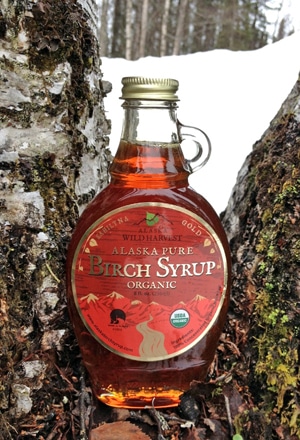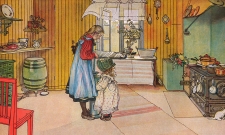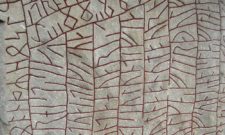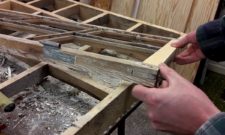Shop our historical maps
Culture
Six tasty things you can make from birch sawdust

Apr
Birch has played an important role for self-sufficient primitive peoples throughout the millennia, including our ancestors here in the Nordic countries. Here are six uses for birch sap, which flows now in spring until the birch buds burst.
The birch did not only give sap to past families. The ferns served as an important roofing material, and were used to make waterproof but lightweight canoes, bowls, baskets and much more. The birch also provided firewood, twigs to make brooms, tar or "Russian oil" to use as a glue, leaves and buds used in folk medicine, and so last but not least, the tree provides an abundant supply of birch sap each spring.
Birch sap has traditionally been a source of spring nutrition in boreal regions of the Northern Hemisphere . The famous Arab traveller Ahmad ibn Fadlān observed as early as 921 that the Turkic-speaking Bolgars along the Volga River drank fermented birch sap.
Food shortages in early spring, in the so-called "hunger gap", were common in northern Europe until the end of the 19th century. This made the extra nutrients and sweet taste of birch sap a welcome addition after a long winter. And in places where water sources were scarce, birch sap was the only drink for shepherds.
"During the last real famine in Sweden, in 1867, birch sap was widely used in southern Sweden for bread baking, porridge and mealtime drinks. The birch was therefore called "poor man's cow" according to a source from southern Sweden." (Uses of tree sap in northern and eastern parts of Europe, p. 345)
Birch sap only collects in spring and winter when the sap is flowing intensely, just after the thaw has left the ground and before the tree has developed buds. In eastern Europe, March is known as "the month of the sap" or "the month of the birch", but at more northerly latitudes in Sweden, April is the best month to collect birch sap.
Here's a short video of arborist Tage Rønne in Denmark showing how he drops birch saws:
Birch S.A.P by Nordic Food Lab at Vimeo.
In simple terms, you drill a hole into the tree at an upward angle. I have seen recommendations for holes 1-2 cm in diameter and 2-6 cm into the tree depending on the thickness of the tree. You can expect to get 5-10 litres of birch sap per tree per day. Here you can see a younger and long-haired version of me making a first attempt at tapping birch sap here at home on the farm a few years ago.
I never thought that video would pass 10,000 views! It may be of interest to know that saw cutting does not kill the tree. Just be sure to plug the hole with a wooden dowel after you're done and don't drill too many holes in the same tree.
Here's a way to tap birch sawdust that leaves less impact on the tree, from Natural Bushcraft:
Another way to cut sap that does less damage to the tree is to cut off the end of a branch where it is around 1 cm in diameter. From that branch you can get up to 1.5 litres of sap in a day, and when you're done you can seal the wound with wax or birch tar.
1. Drink it as it is

Birch sap is widely known for its detoxifying, diuretic and purifying properties, and can be drunk fresh from the tree.
The cartographer Olaus Magnus mentioned in 1555 that Scandinavians tapped birch sap and drank it as a mealtime beverage. The taste is actually quite okay, but I still prefer milk with my meal. Birch sap tastes like water with a slight note of birch and sweetness.
Within a few days, the juice ferments naturally and the taste becomes more acidic, but it can still be drunk. However, it goes bad quickly, usually about a week in the fridge, and can be preserved for longer periods in the freezer or by adding sugar or citric acid - alternatively pasteurising it.
Birch sap contains 17 amino acids, minerals, enzymes, proteins, antioxidants, sugars (xylitol, fructose and glucose), and vitamins B and C, among others.
2. Syrup
Birch syrup is produced in the same way as maple syrup; you reduce the amount of water to concentrate the sugar content. But birch syrup is more expensive, up to five times the price, because you get less syrup from birch sap.

There is about half as much sugar in birch sap as in maple sap, so you need twice as much birch sap to get the same amount of syrup.
Depending on birch species, location, weather and season, birch sap contains 0.5-2% of sugar. So you need 100-150 litres of birch sap to produce 1 litre of syrup.
In commercial production, reverse osmosis machines and evaporators are used to get rid of the water. In Alaska, the total production of birch syrup is around 3,800 liters (1,000 US gallons) per year.
When I have made birch syrup, I have gently boiled the sap. It is easy to burn the sap because of the high fructose content, and it takes a long time to boil off all the water. What you can do to reduce the risk of burning the syrup is to first boil off about 50-75% of the water and then transfer what's left to a double boiler where you boil off the rest.
Birch syrup is delicious on pancakes and a fun experiment.
3. Wine
Birch saplings date back several hundred (if not a thousand) years. It's no more difficult than adding yeast and perhaps sugar to birch sap and letting it ferment into wine.
The following recipe for birch pork is from 1676:
To each gallon (3 litres) mix in half a pound of sugar, and boil it about a quarter or half an hour; then let it cool, and add very little yeast, and it will ferment and purge itself of the little dross which the spirits and sugar may give: then transfer it to a barrel and balm in a little cinnamon and nutmeg, about 15 grams of each to each 30 litres of wine, then seal it up. After a month you can bottle it, and a few days later you have the most deliciously fresh wine with a taste similar to Rhenish wine. [...] The drink won't keep for long unless it's kept cool. (Vinetum Britannicum, p. 176, London, England 1676.)
Here is another more modern recipe (English) and some reflections on making birch wine.
4. oil
"Birch beer" in its most common form in the United States is a carbonated beverage made from herbal extracts and birch bark. It has a taste similar to "root beer".
After the juice is drained, it is distilled into an oil, which is then added to the carbonated beverage to give it its distinctive flavour.
In Europe, birch beer has never been a soft drink, but a real beer with alcohol. It is known from at least the 17th century and was common in northern Europe.
In Sweden, birch sap has been used to brew beer by mixing it with malt and yeast. A description from Småland in 1749 says that beer made from birch sap was sometimes flavoured with porcini (Myrica gale L.).
In southwestern Finland, one type of beer has been made from birch sap mixed with flour and malt.
5. Milk
Usually mead is brewed from water, honey and yeast. To make mead from birch sap, you replace the water with sap. I haven't tried it myself, but I'm guessing it might add a slight note of birch to the mead, plus some nutrition.
6. Vinegar
Throughout Europe, birch sap has been used to make vinegar. Vinegar comes from the French word vinaigre and means "sour wine." Sources say that birch sap vinegar has been used in Sweden, Estonia, Belarus, Hungary, and more. I have not been able to find a recipe, but you should be able to use this from Mother Earth News and use birch sap as the alcohol ingredient.
Read more
Uses of tree saps in northern and eastern parts of Europe
Subscribe to YouTube:
If you appreciate Allmogens independent work to portray our fine Swedish history and Nordic culture, you are welcome to buy something nice in the shop or support us with a voluntary donation. Thank you in advance!
Support Allmogens via Swish: 123 258 97 29
Support Allmogens by becoming a member
Support Allmogens in your will








